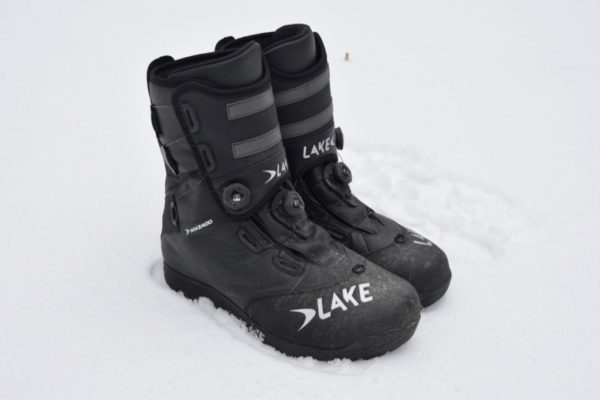
A pair of Lake MXZ 400 boots, size 50 recently arrived on my doorstep. Many fat bikers are familiar with their MXZ 300 line (the current version is the MXZ 303) because it has been the go to winter cycling boot for as long as I can remember (well over a decade now). The MXZ 400 is a recent addition to the Lake line and is offered for people who thought the 303 was just not enough boot for their adventures. They have upped their game compared to the 303 so the 400 can handle extra cold temperatures in several ways: increased insulation, a last that gives more volume for improved circulation and/or wear heavier socks and a taller cuff to provide burly insulation higher up your leg. The price tag is also upped from the MXZ 303 with a retail price of $430. These boots may not come cheap but there is a lot of tech built into them to justify the cost.
Starting with the insulation, Lake uses 400g Thinsulate in the upper which they describe as twice the insulation as the 303. This insulation goes all the way up to the top of the cuff. In comparison boots like the 45NRTH Wölvhammer and Lake MXZ303 pair down the insulation in the upper cuff. There is also a special insole developed by Syksol which looks to be carried over from the MXZ 303. The insole is a combination of felt and what looks to be a heavy duty version of bubble wrap.
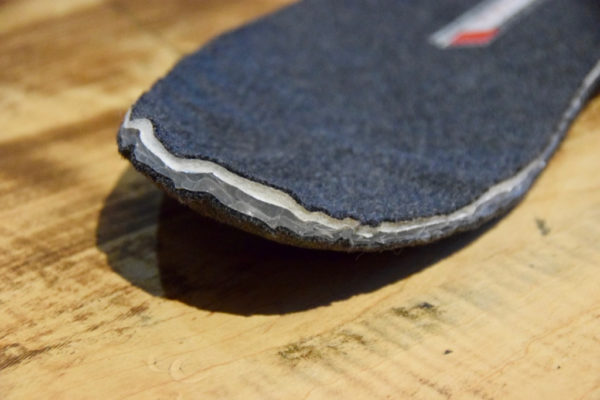
Not only does it have additional insulation compared to the 303, it is also has an “upsized” last to provide a bigger toe box and more room for heavier socks. Lake calls this last “Winter Extreme.” The toe box area has a huge open area and my piggies can wiggle to their heart’s content even with super burly socks on. What is awesome is that the Boa closure on the forefoot still has the ability to crank down tight enough to hold my foot very securely during hard efforts. The heal cup also contributes to the foot being held securely. It doesn’t feel overly rigid but is contoured in a way that holds my heal securely. Once again, the Boa helps a lot here because it not only holds down the front of my foot but it also sucks my foot back into the heal cup. Bottomline: I have as much room as I could ever need for circulation, super thick socks… but I still feel really well connected to the shoe while pedalling like a performance cycling shoe.
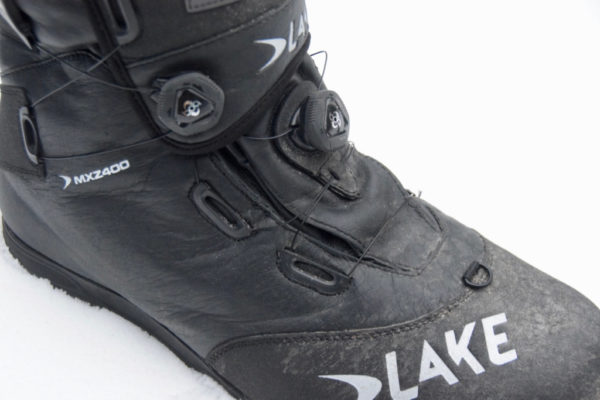
The upper Boa works well too. There are two clasps that make it very easy to get in and out of the boots but the cuff is able to be adjusted in tightness so you can hit the Goldilocks place of no snow or drafts down the cuff but not so tight it impairs mobility or decreases circulation. Speaking of mobility, it is early days with these boot but the cuff does seem to limit ankle movement somewhat. This never bothered me on the bike but is noticeable when hike-a-biking.
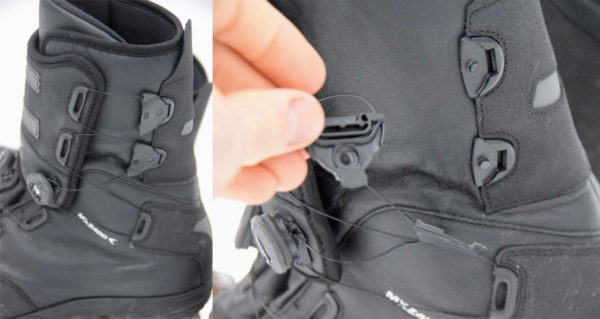
The exterior of the boot has a nice hook for gaiters if you are worried about postholing and snow ingress. There are also nice reflective panels on the front and back. I am a big fan of reflective material because so much winter riding is in the dark due to the short days (at least my riding fits this pattern…).

The grey patches are reflective material
The sole also has a lot of interesting things going on. One of the first features that jump out are the two small toe studs. They are similar to most tire studs with a bigger base and smaller tip but extend a lot further out of the sole. I was kind of paranoid about destroying the floors in my house with these but they are far enough forward that you can pretty easily avoid contacting them on sensitive surfaces. They also seem pretty effective getting off the bike because I normally touch the ground first with the toe of my shoe. They are easy to “deploy” on glare ice if you intentionally walk a bit more on your toes. A more subtle feature of the sole is the use of multiple rubber hardnesses. The lighter grey areas of the sole are a much harder rubber than the soft black rubber used elsewhere. This also seems to help with traction on slippery surfaces.
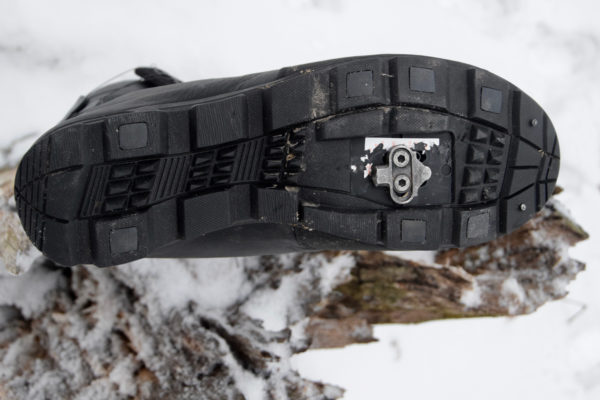
I have only about 100 miles on them so far, mostly in temps between 5 and 20 degrees and so far am very impressed. I was a little worried about their bulk when I first looked at them. They are a size bigger than I probably would have gotten if I had the opportunity to try them on before getting them. I am not sure how much that upsizing contributes but visually they look a lot bigger than my first generation Wölvhammers. The look kind of remind me of moonboots. All of that said, once I had them on I didn’t notice the extra bulk. On the bike they rode like a good pair of cycling shoes but are really warm and dry. Off the bike they felt like normal boot-style cycling shoes. I am really looking forward to using these a bunch for 4+ hour rides this February. Stay tuned more info after I have clocked some serious miles in the Lake MXZ400’s.
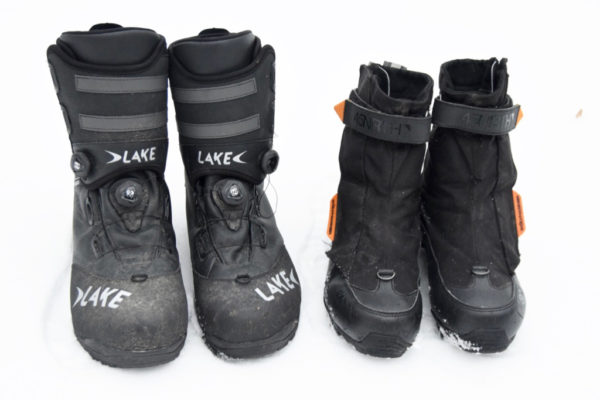
Size 50 MXZ400 vs. first generation Wölvhammer in size 47
For more information about Lake visit – https://lakecycling.com/

I always thought the Boa closure was kind of gimmicky but after buying a pair of work boots with it I am looking for any footwear that has it.
Work boots you say, I am intrigued. What brand?
That’s pretty trick how the upper BOA works. I thought it would be more like what is used on snowboard boots, which would seem to be uncomfortable for riding.
Awesome write up KBS!
Hey Erv. The work boots were Terra’s. Canadian made, composite toe and foot bed and light as air. Feels like wearing a pair of slippers at work!
Cheers,
Allroy
Cheers to you good sir, I will be looking into said foot contraptions post haste!